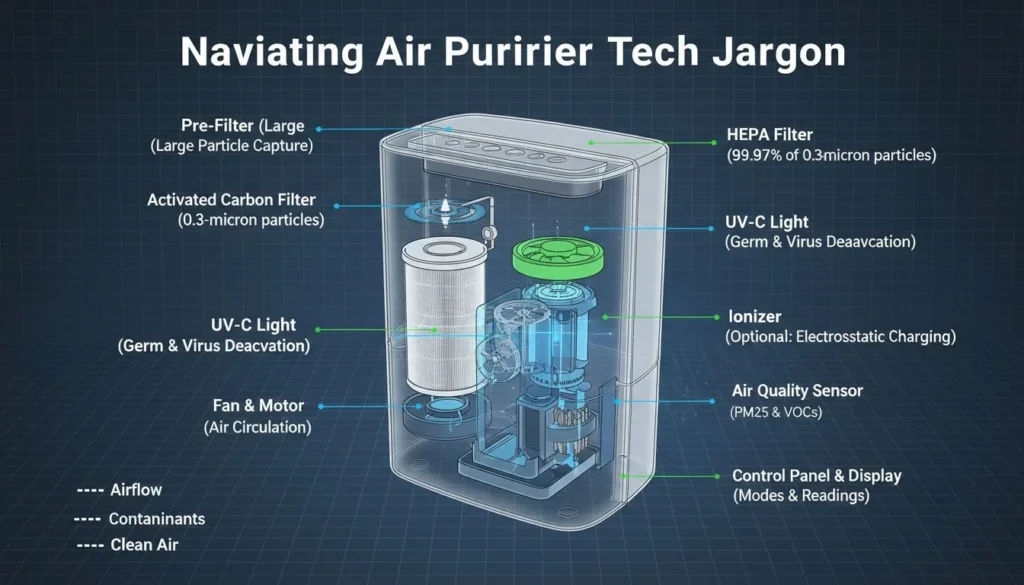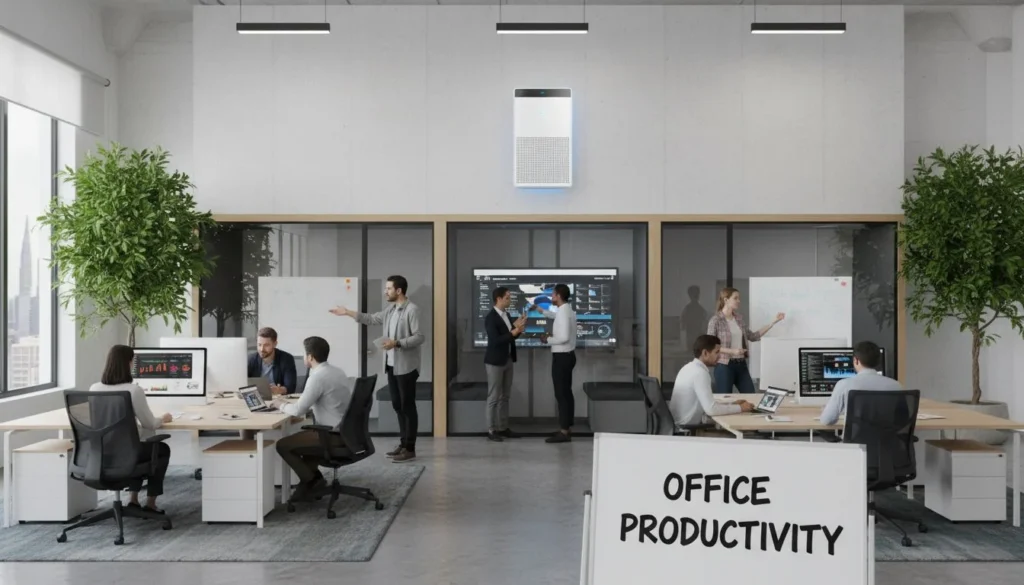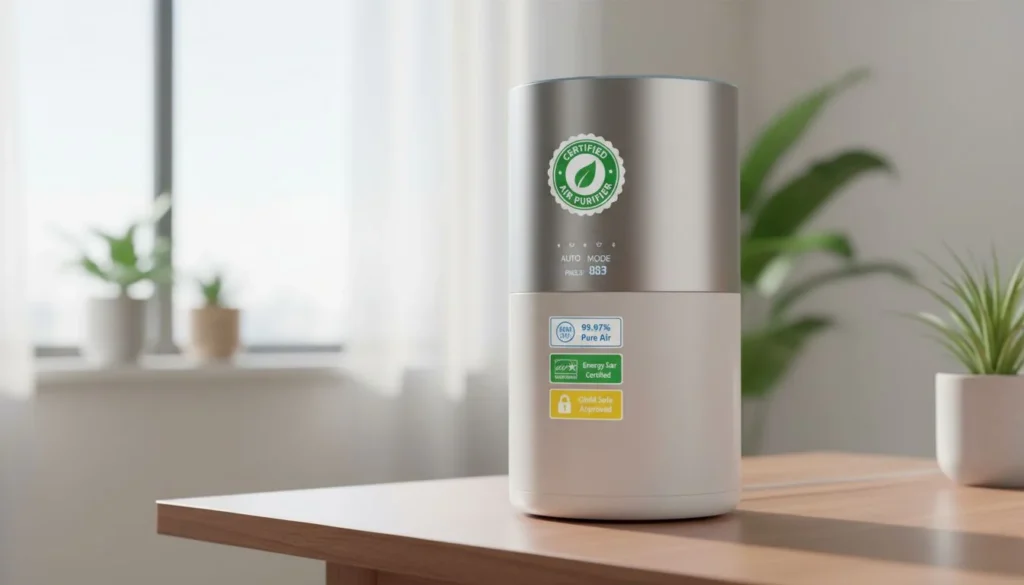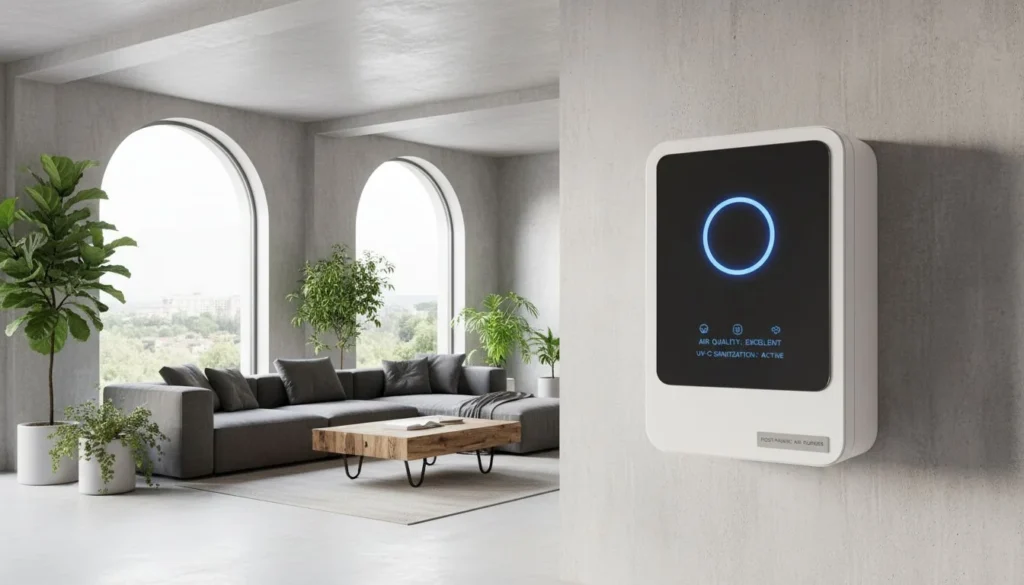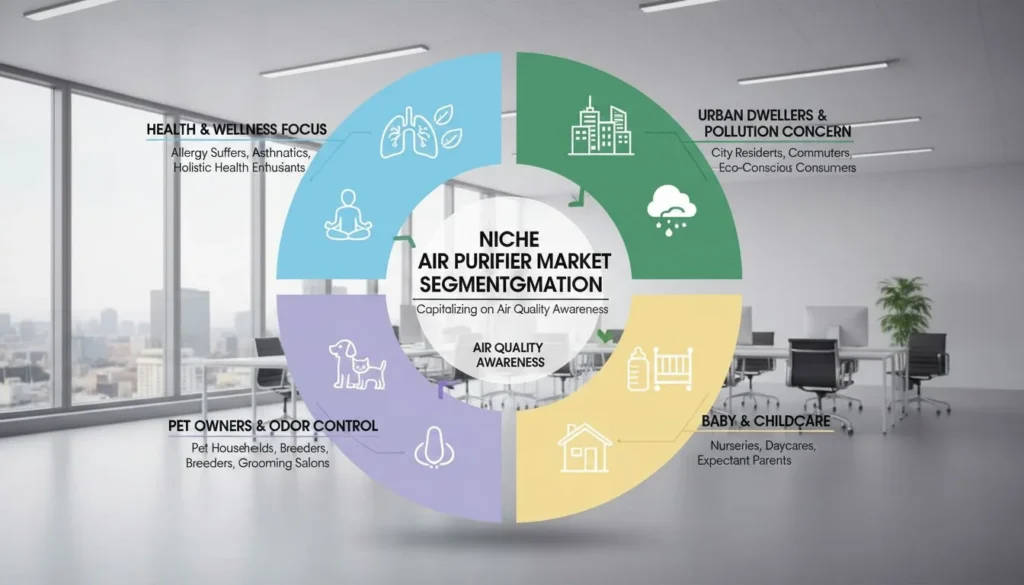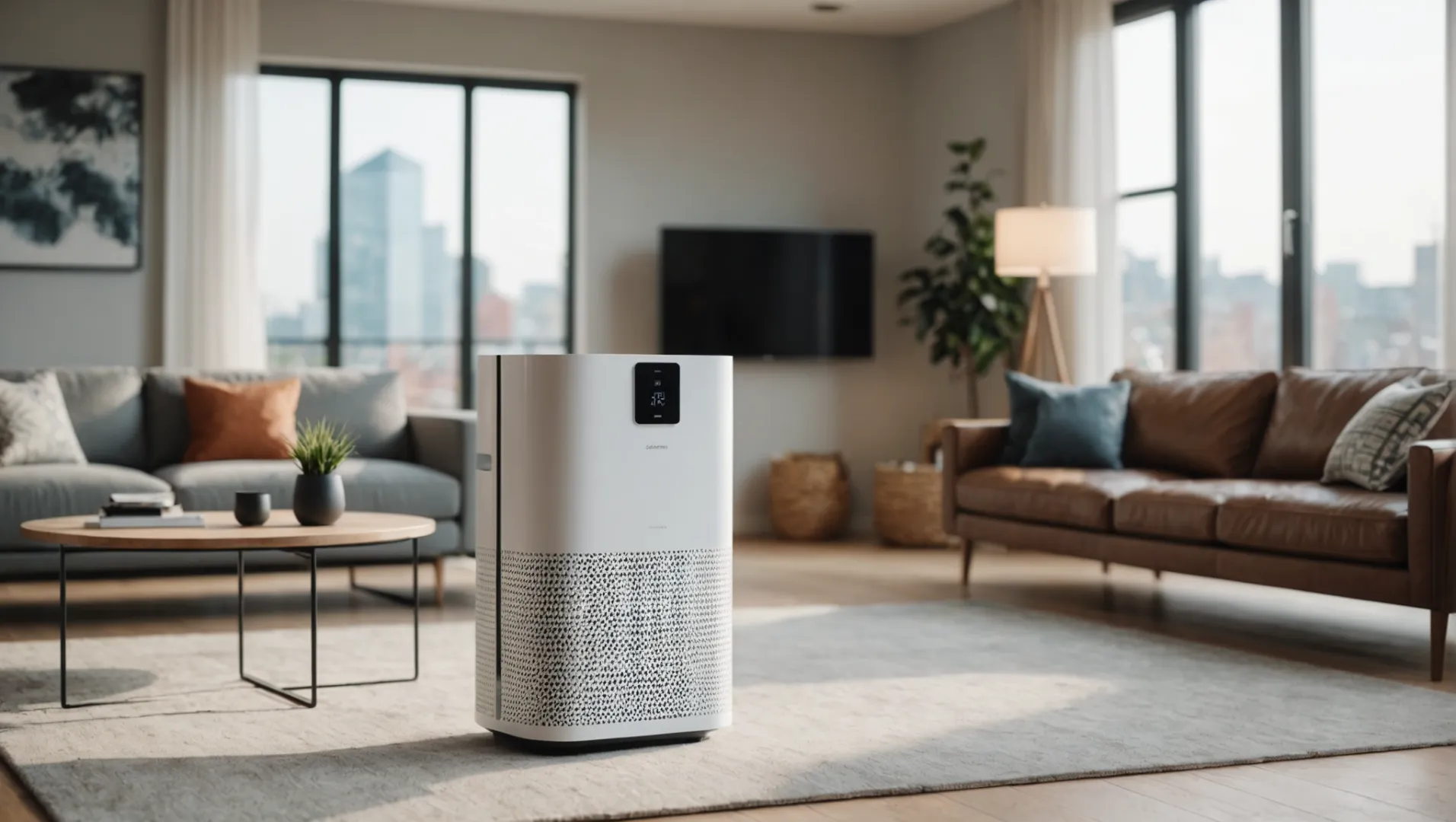
L'avenir de la purification de l'air ne consiste pas seulement à assainir l'air, mais aussi à le rendre plus intelligent.
L'IoT et l'IA peuvent révolutionner les fonctionnalités des purificateurs d'air en permettant des alertes de remplacement de filtre plus précises, en intégrant une variété de capteurs et en personnalisant la gestion de la qualité de l'air pour divers environnements.
Poursuivez votre lecture pour découvrir comment ces technologies ne se contentent pas de résoudre les problèmes du secteur, mais introduisent également des fonctions innovantes qui promettent d'améliorer votre santé et votre efficacité énergétique à la maison.
L'IA dans les purificateurs d'air permet des alertes précises pour le remplacement des filtres.Vrai
L'IA utilise des données et des algorithmes en temps réel pour prédire les dates exactes de remplacement des filtres.
Quels sont les principaux avantages de l'intégration de l'IoT et de l'IA dans les purificateurs d'air ?
Imaginez un monde où votre purificateur d'air s'adapte à votre environnement et s'optimise en fonction de vos besoins.
L'intégration de l'IoT et de l'IA dans les purificateurs d'air offre des avantages tels que des notifications précises de remplacement du filtre, une surveillance environnementale améliorée grâce à des capteurs supplémentaires et une gestion de la qualité de l'air sur mesure pour des paramètres individuels.
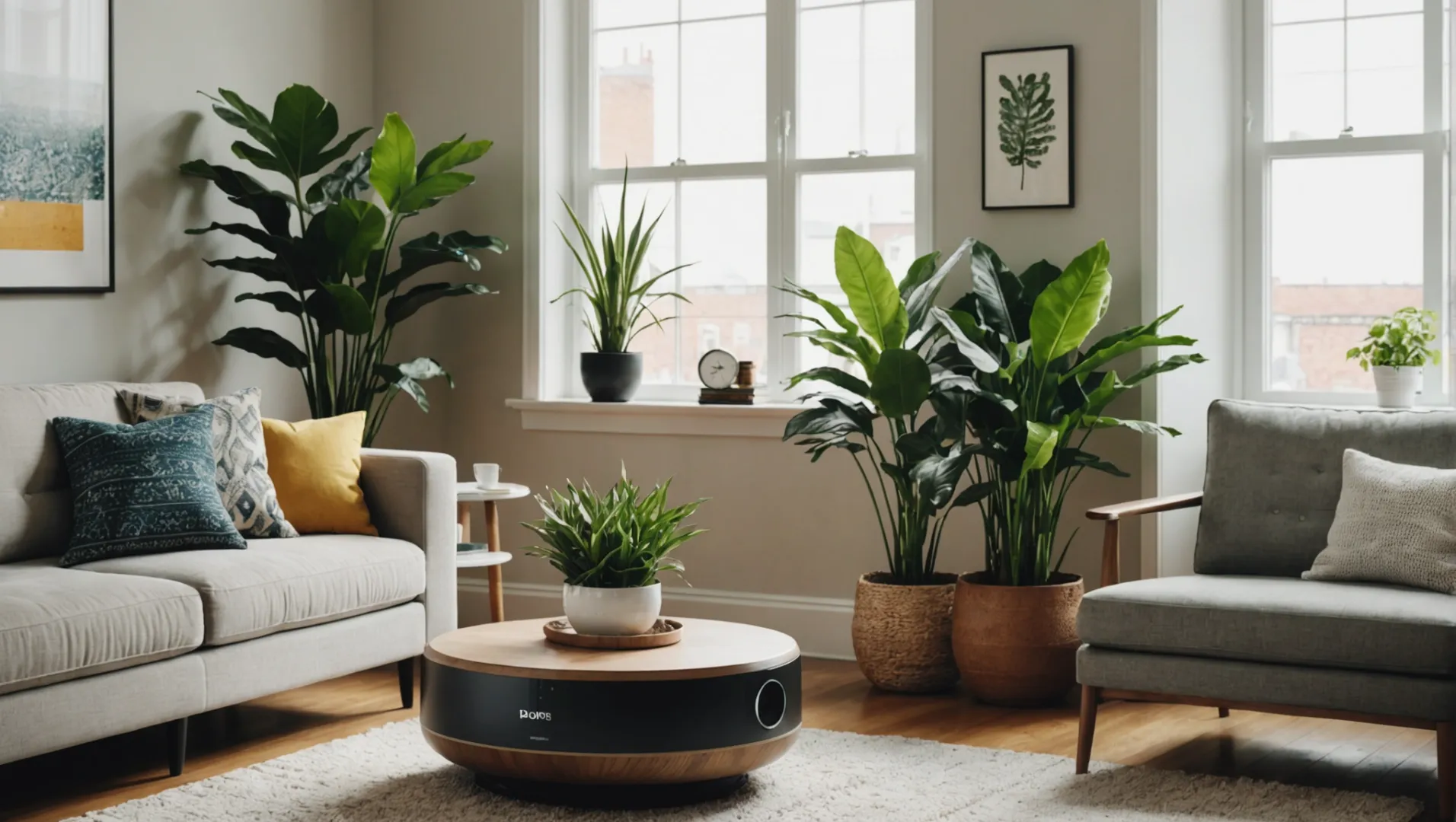
Notifications améliorées de remplacement de filtre
Traditionnellement, les purificateurs d'air rappellent aux utilisateurs de remplacer les filtres en fonction des heures d'utilisation générale, ce qui conduit souvent à des inexactitudes. Cependant, grâce à l'IdO et à l'IA, les fabricants peuvent utiliser des capteurs de pression pour recueillir des données en temps réel, créant ainsi des algorithmes qui prédisent les délais exacts de remplacement des filtres. Cette personnalisation améliore non seulement le confort de l'utilisateur, mais garantit également des performances optimales. La capacité d'adapter les changements de filtres en fonction d'exigences spécifiques en matière de qualité de l'air est une changeur de jeu1 pour les personnes vivant dans des environnements différents.
Surveillance globale de l'environnement
Les purificateurs d'air modernes ne se limitent plus à filtrer les particules. L'intégration de l'IoT et de l'IA permet d'intégrer dans l'appareil une variété de capteurs, tels que des capteurs d'humidité, de température et même de bruit. Cela permet d'obtenir une vision plus globale de la qualité de l'air de l'environnement. Les capteurs avancés tels que les COV (composés organiques volatils), le CO2, le CO et les capteurs de gaz offrent des informations plus approfondies sur les polluants présents, ce qui permet aux utilisateurs de s'attaquer efficacement à des problèmes spécifiques de qualité de l'air.
Gestion personnalisée de la qualité de l'air
En analysant des données provenant de sources multiples, l'IA peut personnaliser le processus de purification. Par exemple, un purificateur d'air pourrait ajuster automatiquement ses réglages en fonction de l'occupation détectée par des capteurs intégrés. Cette adaptabilité permet de maximiser l'efficacité énergétique sans compromettre la qualité de l'air. Des alertes et des recommandations personnalisées peuvent guider les utilisateurs dans la création d'environnements intérieurs plus sains, adaptés à leurs besoins uniques.
Intégration avec les systèmes domestiques intelligents
Grâce à la technologie Matter over Thread, les appareils domestiques intelligents peuvent communiquer de manière transparente sur des plateformes telles qu'Amazon Alexa et Google Home. Cette intégration élargit les fonctionnalités des purificateurs d'air, permettant aux utilisateurs de contrôler et de surveiller leurs appareils via une interface unifiée. Comme tous les capteurs transmettent des données à une plateforme centrale, les utilisateurs obtiennent des informations complètes sur les tendances de la qualité de l'air de leur maison et peuvent prendre des décisions éclairées concernant leur environnement intérieur. De telles innovations soulignent le potentiel de l'IdO et de l'IA pour élever les purificateurs d'air au-delà de simples appareils et en faire des gardiens intelligents de la santé.
L'IoT permet d'alerter en temps réel sur le remplacement des filtres.Vrai
L'IdO utilise des capteurs pour fournir des alertes filtrantes précises et opportunes.
L'IA réduit la consommation d'énergie des purificateurs d'air de 50%.Faux
L'IA optimise les paramètres mais ne garantit pas une réduction de 50%.
Comment les capteurs alimentés par l'IA améliorent-ils la surveillance de la qualité de l'air ?
Les capteurs alimentés par l'IA révolutionnent la surveillance de la qualité de l'air en offrant plus de précision et d'adaptabilité.
Les capteurs alimentés par l'IA améliorent la surveillance de la qualité de l'air en collectant des données en temps réel, en améliorant la précision et en personnalisant les alertes pour des environnements spécifiques.
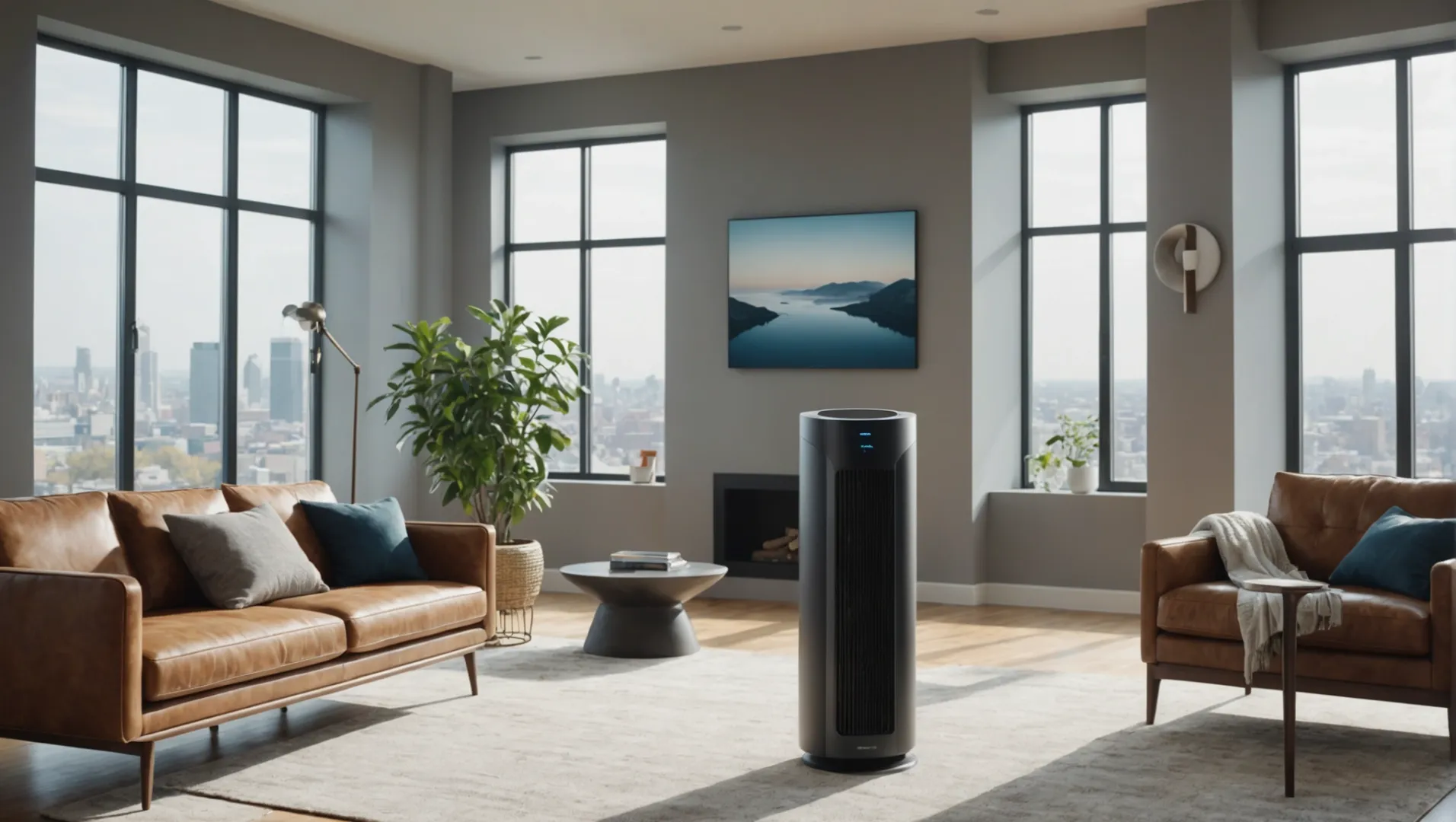
Collecte de données en temps réel
Les capteurs à intelligence artificielle intégrés aux purificateurs d'air collectent en permanence des données en temps réel sur divers facteurs environnementaux. Il s'agit non seulement des particules traditionnelles, mais aussi de l'humidité, de la température et même des composés organiques volatils (COV). En analysant ces points de données, les systèmes d'intelligence artificielle peuvent offrir une vue d'ensemble de la qualité de l'air à tout moment.
Par exemple, en intégrant une combinaison de PM2.5 et de COV, un purificateur d'air peut identifier efficacement les sources de pollution et leurs niveaux. Cette connaissance en temps réel permet d'ajuster immédiatement les paramètres de purification, améliorant ainsi la qualité globale de l'air intérieur.
Amélioration de l'exactitude et de la précision
Les purificateurs d'air traditionnels s'appuient souvent sur des minuteries ou des données manuelles pour déterminer quand les filtres doivent être remplacés. Toutefois, cette méthode est à la fois imprécise et peu pratique pour les utilisateurs dont les conditions environnementales varient. Algorithmes d'IA2 utiliser les données recueillies par les capteurs de pression placés dans les filtres pour prévoir le moment où un remplacement est nécessaire.
Cette capacité prédictive augmente non seulement la précision, mais garantit également que les utilisateurs sont informés des changements de filtres avant toute baisse de performance, ce qui permet de maintenir une purification optimale de l'air.
Personnalisation pour divers environnements
L'intégration de l'IA permet aux purificateurs d'air de s'adapter à différents environnements en apprenant du comportement de l'utilisateur et des conditions extérieures. Par exemple, un purificateur intelligent peut ajuster son fonctionnement en fonction de l'occupation d'une pièce, en utilisant des capteurs d'occupation pour déterminer la présence de personnes.
En outre, la possibilité d'intégrer des systèmes domestiques intelligents tels que Plates-formes fondées sur la matière3 signifie que ces appareils peuvent apprendre les préférences et les habitudes de l'utilisateur. Cette intégration permet une gestion personnalisée de la qualité de l'air qui s'aligne sur les activités quotidiennes et les besoins spécifiques en matière de santé.
Extension de l'intégration des capteurs
Les purificateurs d'air modernes sont désormais équipés d'une gamme de capteurs plus large que celle traditionnellement utilisée. Il s'agit notamment de capteurs de bruit pour réduire les bruits de fonctionnement dans les environnements calmes, de capteurs de lumière pour s'adapter aux conditions ambiantes et de capteurs de CO2 pour contrôler la qualité de l'air intérieur.
Par exemple, le projet "WellCube" de HisoAir intègre plus de 10 capteurs différents, ce qui illustre l'étendue potentielle des données disponibles pour l'analyse des systèmes d'intelligence artificielle. Cette approche permet non seulement d'obtenir des informations complètes sur l'environnement, mais aussi d'améliorer l'expérience de l'utilisateur en prenant en compte de multiples aspects du confort intérieur.
Les capteurs AI ne surveillent que les particules.Faux
Les capteurs d'intelligence artificielle surveillent divers facteurs tels que les COV, l'humidité et la température.
L'IA prédit les changements de filtre à air avant que les performances ne chutent.Vrai
L'IA utilise les données des capteurs de pression pour prédire quand un filtre doit être remplacé.
Les purificateurs d'air intelligents peuvent-ils améliorer les résultats en matière de santé ?
Les purificateurs d'air intelligents peuvent transformer nos espaces de vie en environnements favorables à la santé.
Les purificateurs d'air intelligents peuvent améliorer considérablement les résultats en matière de santé en éliminant les polluants en suspension dans l'air, en fournissant des solutions de qualité de l'air sur mesure et en s'intégrant aux systèmes de surveillance de la santé.
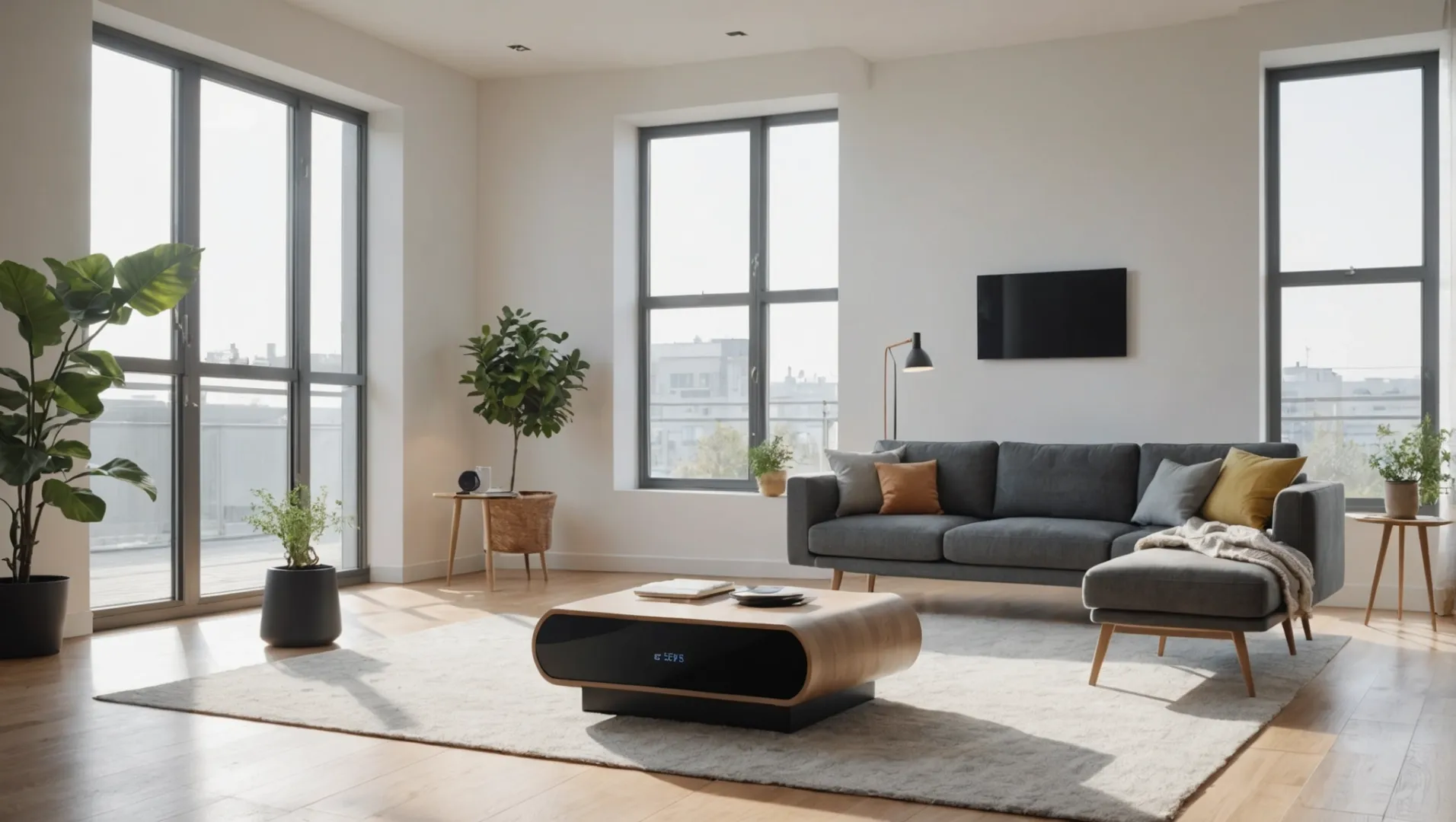
Répondre aux préoccupations en matière de qualité de l'air
Les purificateurs d'air traditionnels n'ont souvent pas la capacité de s'adapter à des conditions environnementales variables, ce qui entraîne une élimination moins efficace des polluants. Les purificateurs d'air intelligents équipés de capteurs avancés peuvent détecter et éliminer un plus grand nombre de contaminants en suspension dans l'air, notamment COV (composés organiques volatils), le CO2 et d'autres gaz dangereux. Cette surveillance précise garantit que la qualité de l'air intérieur est constamment maintenue à des niveaux optimaux, réduisant ainsi le risque de problèmes respiratoires et cardiovasculaires.
Solutions personnalisées pour la qualité de l'air
Avec l'avènement de la technologie de l'IA, les purificateurs d'air intelligents peuvent analyser les données relatives à la qualité de l'air spécifiques à votre environnement domestique. En utilisant des algorithmes d'apprentissage automatique, ces appareils peuvent prédire et ajuster leur fonctionnement en fonction des données historiques et des conditions actuelles. Cette approche personnalisée signifie que les personnes souffrant d'allergies ou de troubles respiratoires, comme l'asthme, peuvent bénéficier d'un environnement adapté à leurs besoins en matière de santé. Par essence, ces purificateurs ne se contentent pas de réagir à la qualité de l'air actuelle, mais anticipent les changements futurs, offrant ainsi une solution proactive.
Intégration aux systèmes de surveillance de la santé
L'intégration de l'IdO dans les purificateurs d'air intelligents permet à ces appareils de communiquer avec d'autres systèmes domestiques intelligents et appareils de santé personnels. Par exemple, la connexion de votre purificateur à une application de santé peut lui permettre d'ajuster les paramètres en fonction de vos données de santé actuelles ou même des prévisions de pollution locales. Comme le souligne le site Le projet WellCube de HisoAir4Grâce à cette intégration, la gestion de la qualité de l'air fait partie d'un écosystème plus large visant à promouvoir le bien-être général.
Améliorations de la santé fondées sur des données probantes
La recherche indique que l'amélioration de la qualité de l'air intérieur a des effets positifs directs sur la santé. Une étude menée par l'Agence de protection de l'environnement a révélé que la réduction des polluants intérieurs peut atténuer les symptômes des personnes souffrant d'asthme et d'autres affections respiratoires. Grâce à la technologie intelligente, les purificateurs d'air peuvent offrir une amélioration plus fiable et plus constante de la qualité de l'air que leurs homologues traditionnels. Cette capacité à maintenir un air plus pur se traduit par des avantages tangibles pour la santé, tels qu'une réduction des visites à l'hôpital et une amélioration de la qualité de vie en général.
Les purificateurs d'air intelligents peuvent prédire les changements de qualité de l'air.Vrai
Ils utilisent l'IA et l'apprentissage automatique pour anticiper la qualité de l'air future.
Les purificateurs traditionnels s'adaptent mieux aux changements environnementaux.Faux
Les purificateurs traditionnels ne disposent pas de capteurs avancés pour l'élimination adaptative des polluants.
Matter est-il l'avenir de l'intégration des purificateurs d'air dans les maisons intelligentes ?
L'avenir des maisons intelligentes évolue avec Matter, qui promet une intégration transparente d'appareils tels que les purificateurs d'air.
Le protocole universel de Matter pourrait unifier les intégrations de purificateurs d'air sur toutes les plateformes, offrant un contrôle rationalisé et une expérience utilisateur améliorée.

Comprendre la matière : Un protocole universel pour la maison intelligente
Matter est une initiative novatrice de l'Alliance pour les normes de connectivité (CSA), anciennement connue sous le nom de Zigbee Alliance. Il vise à simplifier et à unifier les interactions des appareils domestiques intelligents, en veillant à ce que les appareils de différents fabricants puissent communiquer efficacement. Ce protocole prend en charge un large éventail de plateformes, notamment Amazon Alexa, Google Home, Apple HomeKit et Samsung SmartThings.
Le rôle de la matière dans l'intégration des purificateurs d'air
Les purificateurs d'air, équipés d'un ensemble de capteurs tels que PM2.5Les détecteurs de gaz, de COV et de CO2 peuvent bénéficier de manière significative du cadre universel de Matter. Avec Matière5Les utilisateurs peuvent s'attendre à
- Une connectivité sans faille: Quelle que soit la marque ou la plateforme, les purificateurs d'air se connecteront facilement à d'autres appareils domestiques intelligents.
- Contrôle amélioré de l'utilisateur: Contrôle simplifié grâce à une interface d'application unique pour divers appareils.
- Amélioration de l'interopérabilité: Veiller à ce que les mises à jour ou les nouveaux dispositifs s'intègrent sans problème de compatibilité.
Répondre aux problèmes de l'industrie avec Matter
L'un des principaux problèmes rencontrés dans le secteur des purificateurs d'air est l'inexactitude des rappels de remplacement des filtres. Traditionnellement, ces rappels sont basés sur des heures d'utilisation fixes, sans tenir compte des conditions variables de qualité de l'air. Grâce à l'intégration de Matter, les fabricants peuvent exploiter les données IoT pour fournir des alertes de remplacement de filtre précises en utilisant les données des capteurs en temps réel. Technologies de l'IA et de l'IdO6 peut analyser les données relatives à la qualité de l'air afin de prédire avec plus de précision quand un changement de filtre est nécessaire.
Les maisons intelligentes à l'épreuve du temps grâce à Matter
À mesure que l'écosystème de la maison intelligente se développe, l'existence d'un protocole normalisé comme Matter permet aux propriétaires de ne pas être enfermés dans des écosystèmes spécifiques. Il offre flexibilité et évolutivité, permettant aux utilisateurs d'étendre leurs systèmes domestiques intelligents en toute confiance. En outre, des innovations telles que le projet "WellCube" de HisoAir créent un précédent en intégrant de multiples capteurs dans les purificateurs d'air. Ces avancées indiquent une tendance vers des environnements domestiques plus intelligents et adaptables.
La convergence des Matière7 avec des technologies de capteurs avancées et des capacités d'IA dans les purificateurs d'air laisse entrevoir un avenir où les environnements domestiques seront plus sains et plus économes en énergie.
Matter prend en charge l'intégration de Google Home.Vrai
Matter est conçu pour fonctionner avec des plateformes telles que Google Home.
Matter ne peut pas prévoir les changements de filtres à air.Faux
Matter utilise les données IoT pour des alertes précises de remplacement de filtre.
Conclusion
Adoptez les innovations de l'IoT et de l'IA pour une meilleure qualité de l'air et des économies d'énergie.
-
Découvrez comment l'IA optimise les remplacements de filtres pour une meilleure efficacité... : L'IoT et l'IA redéfinissent la purification de l'air en permettant une surveillance en temps réel, des ajustements automatisés et une meilleure efficacité énergétique. ↩
-
Découvrez comment l'IA prédit les changements de filtres pour une meilleure efficacité.. : Cet article présente un tout premier modèle basé sur des réseaux neuronaux artificiels pour prévoir l'ampleur de la réduction des paramètres de qualité de l'air qui peut être obtenue. ↩
-
Découvrez l'intégration transparente entre les différentes plates-formes de la maison intelligente.. : Ce protocole open source garantit la compatibilité de vos appareils. La version 1.3 de Matter offre une meilleure prise en charge des appareils et une meilleure gestion de l'énergie. ↩
-
Découvrez comment WellCube intègre de multiples capteurs pour améliorer la qualité de l'air... : Découvrez comment l'IoT et l'IA améliorent les purificateurs d'air grâce au contrôle en temps réel, à l'automatisation et à l'efficacité énergétique, transformant ainsi la qualité de l'air intérieur. ↩
-
Découvrez comment Matter normalise la communication entre les appareils intelligents pour une meilleure intégration.. : Ce protocole open source garantit la compatibilité de vos appareils. La version 1.3 de Matter offre une meilleure prise en charge des appareils et une meilleure gestion de l'énergie. ↩
-
Découvrez comment l'IA permet un contrôle plus précis et personnalisé de la qualité de l'air : l'IoT et l'IA améliorent les purificateurs d'air en permettant une surveillance en temps réel, des ajustements automatisés basés sur les données de qualité de l'air, et une amélioration de l'énergie.... ↩
-
Découvrez les avantages de l'utilisation de Matter pour l'interopérabilité des appareils.. : Ce protocole open source garantit la compatibilité de vos appareils. La version 1.3 de Matter offre une meilleure prise en charge des appareils et une meilleure gestion de l'énergie. ↩


